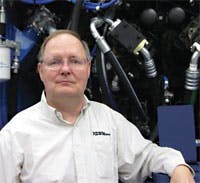editor
[email protected]
Julie Ritchie is the research manager of Penton’s Design Engineering Group, of which Hydraulics & Pneumatics is a part. Julie manages and conducts all sorts of studies about industries, markets, trends, you name it. I always look forward to seeing results of our latest Readership Study for Hydraulics & Pneumatics. The one I just reviewed is from the March 2012 issue.
Julie conducts most of these studies for marketing purposes, to measure the effectiveness of advertisements appearing in the magazine and find out interests of readers. For example, results might suggest which ads were the most remembered by readers. What’s interesting is that some of the highest scoring ads were smaller than a full page, and many appeared in the back of the issue.
One question asked how much time recipients spent reading the issue. More than half (55%, to be exact) indicated that they spent 1 hr or more reading or looking at the issue. Considering our issues have been running about 60 to 70 pages, that tells me readers see everything, from cover to cover.
I think this is consistent with my previous suggestion that readers notice ads based on content and composition, not just size or position. If readers pay close attention to every page, naturally, then, they will notice every ad.
But the statistic that really blew me away was pass-along readership. One of the questions asked, “How many people in your company, other than you, also read or looked at your personal copy of this issue of H&P?” More than a third of the respondents answered that five or more people read or looked at the issue. In fact, 70% of readers wrote that one or more other people read or look at their issue, and a typical reader shares his or her copy with an average of more than five other people. So based on our qualified circulation of 46,169 subscribers, 277,014 people read or looked at the March 2012 issue of Hydraulics & Pneumatics.
This is all pretty heavy stuff to me, so I’ll lighten up a bit. The average reader has subscribed to H&P for eight years. Nearly two thirds (64%) of subscribers save their issue for future reference. More than half (56%) of our readers use social networking at work, with LinkedIn used more than all the others combined.
But I think my favorite part of the study is the section where readers offer their personal comments. This particular study contains 49 pages of comments, so it sounds like many readers are almost as passionate about the magazine as I am!
To read the Readership Study, including reader comments, click here.
To learn more about this or other Readership Studies, contact Ron Klimko.


